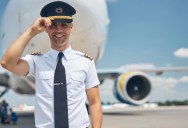There’s An Important Safety Reason Why Many Airline Pilots Don’t Have Beards Or Facial Hair

The older I get, the more I seem to notice that the men and women piloting my airplane look like they’ve barely graduated from high school.
I’ve never necessarily noticed they don’t have facial hair. If you have, though, you’re not crazy. And it turns out, there’s a reason this is the case.
Despite “no beard” not being a Federal Aviation Administration (FAA) policy, several major carriers do have rules regarding facial hair.
An American Airlines representative explained the reason for this to Thrillist.
“We do not allow pilots with facial hair to be on active duty. It’s actually safety driven. Safety is one of the biggest, most important things in our industry.”

In fact, not even off-duty airline crew occupying the “jumpseats” are allowed to have beards or goatees.
Other airlines aren’t quite as strict, with some allowing a neatly-trimmed goatee or reasonable sideburns, and small mustaches are also allowed.
Why is it unsafe, though?
It goes back to a 1987 safety review on effective use of oxygen masks.
“Three popular TSO-approved crewmember oxygen masks equipped with mask-mounted regulators were tested to determine if a decrement in performance would occur as a result of the presence of facial hair.”
It indicated that any facial hair could be an impediment.
“The data resulting from these tests indicated that decrement in performance does occur when facial hair is present along the sealing surface of crew oxygen masks. This decrement is proportional to the amount of facial hair present, the type mask worn, the suspension system associated with the mask, and the exercise level to which the individual is subjected.”
The same goes for bearded passengers, who lose between 16 and 67% of the oxygen from a mask compared to non-bearded passengers.
“The leakages of ambient air caused by beards does not permit an adequate percentage of oxygen to be presented to the lower portion of the respirator tract. The proper functioning of the continuous flow mask relies on having the greatest concentration of oxygen presented at the beginning of inspiration (taking a breath or inhaling) with dilution of oxygen permitted during the latter phase of inspiration. The concentration of oxygen and the inspiration phrase during which it is inhaled are more critical factors than the total oxygen received.”

Something to think about if you love your lumberjack beard and flying.
“Bearded passengers might expect some deficit in oxygenation following a decompression that could lead to varying degrees of hypoxia (physiological conditions that result when the body does not receive enough oxygen). If the mask is properly donned and usual emergency descent procedures can be followed, the deficit in oxygenation might not be severe enough to be life-threatening, but could cause loss of consciousness.”
I mean, this probably won’t happen on your flight.
But if it does, keep an eye on your bearded friends.
If you thought that was interesting, you might like to read about a quantum computer simulation that has “reversed time” and physics may never be the same.

Sign up to get our BEST stories of the week straight to your inbox.




